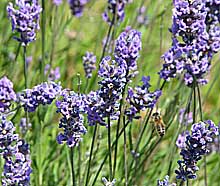Growing Lavender for scented flowers in the garden
GROWING GUIDES
- How to Grow Asparagus
- Asparagus disease
- Harvesting Asparagus
- How to grow Beetroot
- Brussels Sprouts
- How to grow Carrots
- Garlic
- Garlic Chives
- Growing Leeks
- Globe Artichoke
- Growing Parsnips
- Jerusalem Artichoke
- Carrot Problems
- Harvesting Carrots
- Buying Carrot Seed
- Parsnip Problems
- Harvesting Leeks
- Harvesting Runner Beans
- Growing Runner Beans
- Runner Bean Problems
- French Beans
- Organic Gardening
- Organic Pest Control
- Herbs Indoors
- Herb Nurseries
SEASONAL TIPS
Spring
Cut back leafy stems by about 2—3cm to encourage bushy growth.
Cut back straggly plants more severely to create denser growth.
Late Spring
Plan your garden -decide whether to plant a single lavender or a row of
plants to create a fragrant hedge.
Make sure that the planting area is weed-free. Plant out cuttings taken
from mature plants.
Summer
Harvest the aromatic stems of lavender to keep plants in a tidy shape.
Use the spent flower-heads in lavender bags or in a fragrant pot-pourri

PLANT SOCIETIES
LAVENDER - LAVENDULA
 Lavender
is a popular herb for the garden it is prized for both its fragrance
and its colour.
Lavender
is a popular herb for the garden it is prized for both its fragrance
and its colour.
The flowers are rich in essential oil which is obtained by distillation - lavender oil is used extensively in perfumery.
Dried lavender flowers are traditionally used for filling sachets and for placing amongst linen
The lavender belongs to the Mint family, Labiatae. Some types of lavender plants are perennial herbs, others are shrubs.
The two main species are English and French Lavender.
ENGLISH LAVENDER
 English
lavender (Lavandula angustfolia) has long grey or pale
blue stems that grow delicate flower spikes in mid to late summer.
English
lavender (Lavandula angustfolia) has long grey or pale
blue stems that grow delicate flower spikes in mid to late summer.
The deepest purple of all lavenders is ‘Hidcote’, which also has fragrant silvery foliage.
There are a few pink lavenders too, such as ‘Hidcote Pink’ and ‘Loddon Pink’. There is even a pure white ‘Nana Alba’.
FRENCH LAVENDER
French lavender ( L. stoechas) is also known as butterfly lavender because of the flower shape.
Thc blooms are purple-pink and appear at the same time as those of English lavender.
WHERE TO PLANT LAVENDER
Lavender plants thrive best in a sunny, sheltered position, for the winter temperature of most parts of the British Isles is lower than that of their native habitats.
The most suitable soil is a light, well drained, sandy loam in which leafmould and well rotted manure have been mixed. In this type of soil the plants are much less liable to damage by frosts than when grown in heavy, wet ground. However lavender can often grow well in poor soil that other plants might find challenging
Lavender makes an enchanting informal aromatic hedge inside the garden. It can also be grown sucessfully in containers as it needs little maintenance.
Add elegance to a rock garden with ‘Munstead’, a compact English variety that grows just over 60cm tall or add to a herb garden.
PRUNING LAVENDER OR LAVENDULA PLANTS
Prune the lavender plants to keep them in a tidy shrub form.
Pruning or trimming should be done each year in late summer, as soon as the blooms have faded, so that the bushes have time to make a little new growth before winter.
Hard pruning is sometimes done in April, but this means the loss of a season’s flowers.
When lavender bushes become old and straggling it is
better to start again with young bushes rather than to try to re-condition
them by hard pruning.
COMPANION PLANTING
Its silver-grey foliage and erect stems make lavender excellent for complementing the shapes and colours of other plants in the garden.
Shades of soft pink and pastel blue blend well with the grey-green foliage of lavender.
For a soothing colour scheme, combine cornflower, pinks, and white, blush-pink or magenta yarrow Achillea with lavender
Use low-growing thyme such as pink- blooming ‘Bressingham Pink’, to carpet a lavender-filled rock garden.Together they bring soft sweeps of colour .
Culinary herbs, such as rosemary, oregano and sage thrive in the same sunny sites and dry, well-drained soils that lavender prefers.
PROPAGATION OF LAVENDER PLANTS
Propagation of the shrubby Lavenders is by cuttings made of the side shoots during August or early September. These should be 3 or 4 in. long and inserted in sandy soil out of doors then covered with a cloche.
The following spring the rooted cuttings should be planted on a reserve border. The tops must be pinched off to make the plants branch and in October the young plants should be set in their permanent positions.
Lavender plants, especially the dwarf varieties, are
frequently propagated by pulling the old plants to pieces in early October
and planting them where they
are to remain; even if they have no roots the pieces will thrive.
Most of the Lavenders can also be grown from seeds sown in boxes of sandy
soil in a cold frame or greenhouse in spring
LAVENDER PROBLEMS
Frothy blobs on lavender stems in May indicate the presence of froghoppers.
The young of these insects are hidden in the froth. They suck the plant’s sap but cause little harm. Blast them off with a jet of water from a hose.